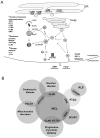Neuronal ceroid lipofuscinosis: impact of recent genetic advances and expansion of the clinicopathologic spectrum
- PMID: 23775425
- PMCID: PMC3774306
- DOI: 10.1007/s11910-013-0366-z
Neuronal ceroid lipofuscinosis: impact of recent genetic advances and expansion of the clinicopathologic spectrum
Abstract
Neuronal ceroid lipofuscinosis (NCL), first clinically described in 1826 and pathologically defined in the 1960s, refers to a group of disorders mostly diagnosed in the childhood years that involve the accumulation of lysosomal storage material with characteristic ultrastructure and prominent neurodegenerative features including vision loss, seizures, motor and cognitive function deterioration, and often times, psychiatric disturbances. All NCL disorders evidence early morbidity and treatment options are limited to symptomatic and palliative care. While distinct genetic forms of NCL have long been recognized, recent genetic advances are considerably widening the NCL genotypic and phenotypic spectrum, highlighting significant overlap with other neurodegenerative diseases. This review will discuss these recent advances and the expanded potential for increased awareness and new research that will ultimately lead to effective treatments for NCL and related disorders.
Conflict of interest statement
Figures

References
-
- Mole SE, Williams RE, Goebel HH. Contemporary Neurology Series. Second. Oxford: Oxford University Press; 2011. The Neuronal Ceroid Lipofuscinoses (Batten Disease)
-
- Jarvela I, Autti T, Lamminranta S, Aberg L, Raininko R, Santavuori P. Clinical and magnetic resonance imaging findings in Batten disease: analysis of the major mutation (1.02-kb deletion) Ann Neurol. 1997;42(5):799–802. - PubMed
-
- Mole SE, Williams RE, Goebel HH. Correlations between genotype, ultrastructural morphology and clinical phenotype in the neuronal ceroid lipofuscinoses. Neurogenetics. 2005;6(3):107–26. - PubMed
Publication types
MeSH terms
Grants and funding
LinkOut - more resources
Full Text Sources
Other Literature Sources
Miscellaneous

